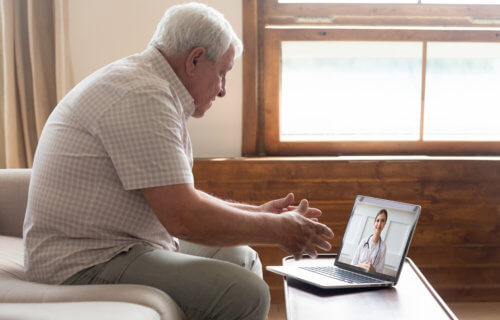CAMBRIDGE, United Kingdom — Video consultations with doctors, sometimes called telemedicine or telehealth, may be more convenient than an in-person visits during the pandemic for some, but are possibly disastrous for others, scientists warn. According to a new study, patients who suffer from mental health issues or hearing problems could lose out as health services switch from face-to-face appointments to video chats and phone calls.
Video consultations increased dramatically during the global pandemic, as it was unsafe for patients to consult their PCPs in person, but few studies have examined what impact this shift has had on patient care, especially for those suffering from complex health conditions. Now, scientists at the University of Cambridge have found that most patients and doctors agree that face-to-face meetings trump digital ones when it comes to giving a diagnosis.
“My rheumatologist cannot see or hear how I move, look at my skin, eyes, hair, hands, bones, how I am. I was diagnosed with something over the phone, which I know isn’t right, and it’s getting worse,” one patient explains.
“Our research exposes the inherent risks and benefits of telemedicine for patients with complex conditions, which may have important implications for patients who have other serious or unpredictable long-term conditions,” says study lead author and postgraduate researcher Melanie Sloan in a university release.
“As the NHS (National Health Service) develops a telemedicine strategy, we hope there will be a thorough assessment of the clinical and psychological risks and steps taken to mitigate those risks, as well as action to address the possibility of worsening existing health inequalities for those less likely to be able to benefit from remote consultations.”
Which patients struggle the most with telehealth?
The study included an online survey involving 1,340 patients (96% from the U.K.) and 111 clinicians. During the study period between April and July 2021, 31 patients and 29 clinicians conducted in-depth interviews. Results showed that 32 percent of patients suffered from arthritis and 32 percent had lupus.
Most clinicians and patients agree that it was harder to build trusting medical relationships over video conference, but add if they already had a strong bond with a patient, it was easier to “go remote.” Doctors stressed the importance of responding quickly to “flaring” patients with a rapidly worsening condition.
However, only around half of the patients believed their urgent requests would receive a doctor’s attention within 24 to 48 hours. While some patients praised “prompt responses,” others struggled with administrative systems to get an answer or had trouble booking an appointment all together.
“Waiting for a call back after 4 voicemails… feel sad and scared knowing that when I really need medical help I have no-one,” one young lupus patient says.
There were also concerns that video consultations could increase inequalities in treatment, with certain groups of patients at a “substantial disadvantage.” These included people with undiagnosed or more complex health conditions, those for whom English was not a first language, or who had hearing difficulties. Additionally, patients with cognitive or speech difficulties and those experiencing social or economic hardship or mental health problems were identified as vulnerable.
“We’ve had some local practices only allowing contact through e-consult (electronic consultation), so that means that if you can’t use it, you’re elderly, English [is] not your first language, you’ve got learning difficulties… it’s not fair. They’re doing that whole barrier to protect their time,” a senior general practitioner adds.
How can doctors make the system better?
Over 60 percent of patients and clinicians reported that video consultations were more convenient than meeting face-to-face, pointing out benefits including no need to travel, a reduction in wait times, and safety during the COVID-19 pandemic. This was especially true for those employed or who just needed a quick check-up, prescriptions, or administrative queries.
“I am very glad that telemedicine has become an option as it not only makes me feel more relaxed and safer, but I often have great difficulty getting to [the] hospital,” another lupus patient explains.
Moreover, there were concerns that the NHS and hospital management uses video consultations as a cost and time-saving measure. Overall, the vast majority of respondents — 86 percent of patients and 93 percent of clinicians — were critical of remote consultations, with some reporting misdiagnoses. In contrast, just three percent of clinicians felt video appointments were better than meeting face-to-face.
They also felt that the NHS and managers were pushing the remote agenda more than their own preferences.
“The rapid digitalization and use of telemedicine must stay but appropriate patient selection is key, it is perfect for some but disastrous for others,” a senior clinician taking part in the study warns.
Researchers conclude that video consultations could become more palatable by improving training for clinicians and offering patients more choice. Carefully selecting people who are suitable for remote appointments is also key.
“Some stable rheumatic disease patients can benefit from telemedicine but new patients, those with worsening symptoms or more complex conditions such as lupus need quickly accessible, face-to face appointments to manage their conditions,” co-author Professor Caroline Gordon concludes.
The findings were published in the journal Rheumatology.
South West News Service writer Tom Campbell contributed to this report.
